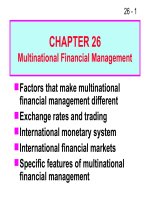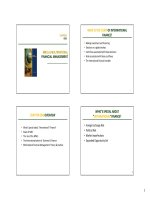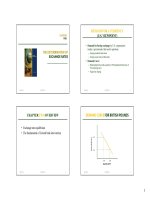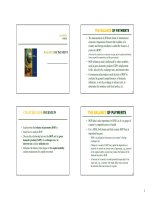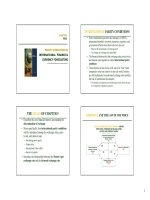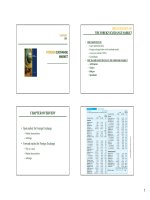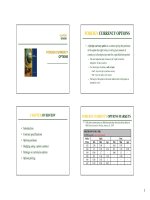Multinational financial management 7th CH03
Bạn đang xem bản rút gọn của tài liệu. Xem và tải ngay bản đầy đủ của tài liệu tại đây (875.56 KB, 38 trang )
Multinational Financial
Management
Alan Shapiro
7 Edition
th
J.Wiley & Sons
Power Points by
Joseph F. Greco, Ph.D.
California State University, Fullerton
1
CHAPTER 3
THE INTERNATIONAL
MONETARY SYSTEM
2
CHAPTER OVERVIEW
I.
ALTERNATIVE EXCHANGE RATE
SYSTEMS
II.
A BRIEF HISTORY OF THE
INTERNATIONAL MONETARY SYTEM
III. THE EUROPEAN MONETARY
SYSTEM AND
MONETARY UNION
IV. EMERGING MARKET CURRENCY
CRISES
3
PART I. ALTERNATIVE
EXCHANGE RATE SYSTEMS
I.
FIVE MARKET MECHANISMS
A. Freely Floating
(“Clean Float”)
1. Market forces of
supply and
demand
determine
rates.
4
ALTERNATIVE EXCHANGE RATE
SYSTEMS
2. Forces influenced by
a.
price levels
b.
c.
interest rates
economic growth
3. Rates fluctuate randomly
over time.
5
ALTERNATIVE EXCHANGE RATE
SYSTEMS
B.
Managed Float (“Dirty Float”)
1. Market forces set rates
unless excess volatility
occurs.
2. Then, central bank
determines
rate.
6
ALTERNATIVE EXCHANGE RATE
SYSTEMS
C.
Target-Zone Arrangement
1. Rate Determination
a. Market forces constrained
to
upper and lower range of rates.
b. Members to the arrangement
adjust their national economic
policies
to maintain target.
7
ALTERNATIVE EXCHANGE RATE
SYSTEMS
D. Fixed Rate System
1. Rate determination
a. Government maintains target rates.
b. If rates threatened, central
banks
buy/sell currency.
c. Monetary policies coordinated.
8
ALTERNATIVE EXCHANGE RATE
SYSTEMS
E.
Current System
1.
freelyand
rate
A hybrid system
a.
Major currencies:
use
floating method
b.
Other currencies move in
out of various fixedsystems.
9
PART II. A BRIEF HISTORY OF THE
INTERNATIONAL MONETARY SYSTEM
I. THE USE OF GOLD
A. Desirable properties
B. In short run: High production costs
limit
changes.
C. In long run: Commodity money
insures stability.
10
A BRIEF HISTORY
II.
The Classical Gold Standard
(1821-1914)
A.
Major global currencies on gold
standard.
1.
Nations fix the exchange
rate
in terms of a specific
amount
of gold.
11
A BRIEF HISTORY
2.
that
3.
Maintenance involved the
buying and selling of gold at
price.
Disturbances in Price Levels:
Would be offset by the pricespecie*-flow mechanism.
* specie = gold coins
12
A BRIEF HISTORY
a. Price-specie-flow mechanism
adjustments were automatic:
1.) When a balance of payments surplus
led to a gold inflow;
2.) Gold inflow led to higher prices which
reduced surplus;
3.) Gold outflow led to lower
and increased surplus.
prices
13
A BRIEF HISTORY
III.
The Gold Exchange Standard
(1925-1931)
A.
Only U.S. and Britain allowed
to hold gold reserves.
B.
Others could hold both gold,
dollars
or pound reserves.
14
A BRIEF HISTORY
C. Currencies devalued in 1931
- led to trade wars.
D. Bretton Woods
Conference
- called in order to avoid
future protectionist and
destructive economic policies
15
A BRIEF HISTORY
V.The Bretton Woods System (1946-1971)
1. U.S.$ was key currency;
valued at $1 - 1/35 oz. of
gold.
2. All currencies linked to
in a fixed rate system.
that price
16
A BRIEF HISTORY
3.
Exchange rates allowed to
fluctuate
by 1% above or
below initially set
rates.
B. Collapse, 1971
1.
Causes:
a.
U.S. high inflation rate
b.
U.S.$ depreciated sharply.
17
A BRIEF HISTORY
V.Post-Bretton Woods System (1971Present)
A. Smithsonian Agreement, 1971:
US$ devalued to 1/38 oz. of gold.
By 1973: World on a freely floating
exchange rate system.
18
A BRIEF HISTORY
B. OPEC and the Oil Crisis (1973-774)
1.
OPEC raised oil prices four fold;
2.
Exchange rate turmoil resulted;
3.
Caused OPEC nations to earn
large
surplus B-O-P.
19
A BRIEF HISTORY
4. Surpluses recycled to debtor
nations which set up debt
crisis of 1980’s.
C. Dollar Crisis (1977-78)
1. U.S. B-O-P difficulties
2. Result of inconsistent
monetary policy in U.S.
20
A BRIEF HISTORY
3. Dollar value falls as confidence
shrinks.
D. The Rising Dollar (1980-85)
1. U.S. inflation subsides as the Fed
raises interest rates
2. Rising rates attracts global capital to
U.S.
21
A BRIEF HISTORY
3. Result: Dollar value rises.
E. The Sinking Dollar:(1985-87)
1. Dollar revaluated slowly
downward;
2. Plaza Agreement (1985)
G-5 agree to depress US$
further.
22
A BRIEF HISTORY
3.
Louvre Agreement (1987)
G-7 agree to support the
falling US$.
F. Recent History (1988-Present)
1.
1988 US$ stabilized
2.
Post-1991 Confidence
resulted in stronger
dollar
3.
1993-1995 Dollar value
falls
23
PART III.
THE EUROPEAN MONETARY SYSTEM
I. INTRODUCTION
A. The European Monetary
System
(EMS)
1. A target-zone method
(1979)
2. Close macroeconomic
policy coordination
required.
24
THE EUROPEAN MONETARY SYSTEM
B. EMS Objective:
to provide exchange rate
stability to all members by
holding exchange rates
within specified limits.
25
